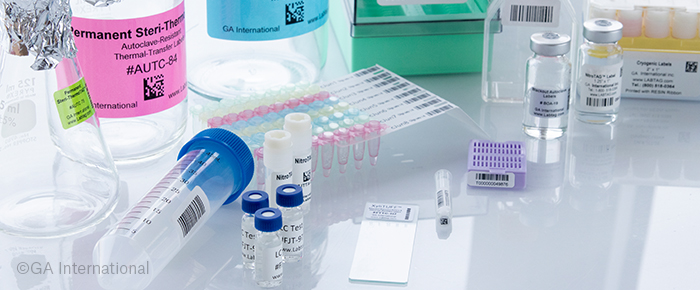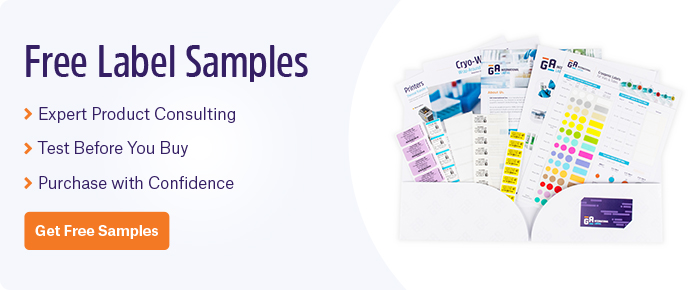Labels help your laboratory get organized and track essential data. Here’s a quick rundown of 30 lab items waiting to be labeled.
1)Vials & Microtubes
Vials and microtubes are likely the most used container in your lab. Whether used to make aliquots, serial dilutions, or for cryogenic storage, they should always be clearly identified with printed and barcoded labels. Cryogenic labels are a versatile option that can be used for most vials, though labeling options are also available specifically for indented caps, and already frozen vials.
2) Boxes
The primary use for these plastic or cardboard boxes is to store tubes and vials in refrigerators, freezers, and liquid nitrogen tanks. These cryo/freezer boxes necessitate cryogenic or deep-freeze labels that will withstand storage under those conditions.
3) Cryo Straws
Cryogenic straws and vitrification devices require a unique cryo label that will wrap-around their small diameter and resist the vitrification process.
4) Freezer Bags
Freezer bags are the suggested containers for sample tubes that have a volume greater than 5 ml. They can be used to store various specimen in refrigerators and freezers. Bags are made of a flexible film and therefore require a label that is equally flexible to avoid cracking or peeling when frozen.
5) Blood Bags
All manufactured blood components have a standard format label applied to the bag. This base label must align with the ISBT 128 labeling standard and have an adhesive that complies with U.S. FDA 21 CFR 175.105. Secondary blood bag labels can be applied over the primary blood bag label without being FDA approved.
6) Metal Racks for Cryo Boxes
Metal racks are used in low-temperature freezers and liquid nitrogen Dewars to organize your cryogenic boxes. The sides and tops of these racks can be identified to speed up sample retrieval.
7) Canes
Cryogenic vials can also be stored in liquid nitrogen tanks using aluminum cryo canes. They typically hold five vials at a time and are intended to be labeled at the top for easy identification.
8) Canisters for Straws
Canisters allow cryo straws to be safely stored in liquid nitrogen, for long-term storage. They require cryogenic labels designed for metal surfaces that are printed with barcodes and readable text.
9) Plates & Microplates
Microplates are used for a variety of applications, from PCR, ELISA, and cell culture. These plates require a narrow label as they provide limited space for identification, restricted to a small area around the side.
10) Dishes
Petri dishes have many uses in the lab, particularly for cell culture. Like plates, they have a limited labeling surface, though they can also be labeled on their underside using clear, reverse-printed labels.
11) PCR Strips
8-Tube-strips are commonly used to run PCR and qPCR experiments and can be labeled using a perforated label strip that breaks into 8 pieces to identify each well.
12) Microscope Slides
Microscope slides are a common tool used in histology and for a host of imaging experiments. As such, slide labels must resist harsh chemicals and various stains.
13) Wax Blocks
Paraffin wax blocks used during the histological process can pose a challenge for identification. We recommend thermal-transfer chemical-resistant labels specially made for hard-to-stick surfaces.
14) Resin Embedding
Samples intended for use in electron microscopy must first be embedded in resin. Accurate identification of these samples requires a label that can be polymerized into the resin, along with the sample.
15) Culture Flasks
The most commonly used container for growing mammalian cells. They are available in a range of sizes, regularly disinfected, and are designed for storage inside cell culture incubators. As such alcohol-resistant and heat-resistant labels are suggested for these containers.
16) Volumetric Flasks
Used primarily by chemistry labs to make a solution to a precise volume. Chemical-resistant flag labels are recommended as they will not obscure their graduation when preparing solutions.
17) Bottles
Bottles used to store lab buffers and solutions should be identified with labels resistant to incidental exposure to lab chemicals. If used during autoclave cycles, the labels should also withstand sterilization.
18) Disposable Plastic Containers
Disposable containers are a versatile, low-cost tool used by many labs to perform various tasks, such as during western blot washes or for storage of samples in lab refrigerators, requiring laboratory freezer labels.
19) Surgical Instruments
Several labs use surgical instruments during their animal experiments. These instruments naturally need to be adequately sterilized between experiments and should be identified using autoclave-resistant labels for this purpose.
20) Syringes
Medical syringes are used for animal work and specific experiments in the lab. Flag syringe labels allow these syringes to be clearly labeled without obscuring their contents or graduation.
21) Sterilization Containers & Pouches
Loose material and labware can be sterilized inside containers or pouches designed for that purpose. These containers should be identified with autoclave-resistant labels and sterilization indicator tape.
22) Pipettes
Pipettes in a lab can be allocated to an individual scientist or for a specific application. For example, a set of pipettes might be allocated explicitly for PCR and RNase-free experiments. General color lab labels or tape allow for quick identification via color-coding.
23) Equipment
Various equipment in the lab needs to be regularly calibrated and maintained. Laboratory calibration labels are a great way to indicate calibration date, status, and the technician’s contact information.
24) Freezer Shelves
Freezers can quickly fill up with reagents, samples, and reaction buffers. Cryo labels can help keep them organized by identifying shelves, racks, and drawers.
25) Safety Cabinet
Labs use safety cabinets to store hazardous chemicals. Laboratory safety labels, such as GHS labels, are a great way to ensure staff is aware of the potential risks and safety guidelines.
26) Notebook
General use lab labels can be used to color code and better organize your lab notebook. Printed labels can also be used to track samples and then added to a notebook to annotate a particular experiment further.
27) File Folders
Working in the lab also requires a certain amount of paperwork. From articles to written notes, grants, and papers. Keep everything organized in a filing cabinet with well-identified folders using general use color labels.
28) Animal Enclosures
Many labs work with small animals, on which they perform various experiments. Their enclosures often need to be labeled with genetic information, current treatments, and other data. Laminated labels are a great option, as they will resist a variety of environments, including abrasion and chemicals.
29) Workbench
There are instances where your workbench may also need to be labeled. This can include notes, reminders, or simply relevant information that you need easy access to. Removable labels make cleanup simple, as they leave no adhesive residue behind.
30) Radioactive Material
Labs that work with radioactive material need to properly label any equipment that comes into contact with anything radioactive. This includes benches, pipettes, and the freezer used for storage. Radioactive warning labels are available in various sizes for this purpose.
LabTAG by GA International loves labels and identification solutions. Helping you organize and track essential data is what we do. A leading manufacturer of high-performance specialty labels and a supplier of identification solutions used in research and medical labs as well as healthcare institutions.





